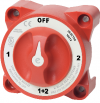- Joined
- Apr 2, 2023
- Messages
- 27
- Reaction score
- 4
- Points
- 3
- Age
- 42
- Model
- CHOOSE
Hi.. as the title states, I’m in the process of re-wiring my 84 Tournament 170. Under the console was a huge rats nest of wires with splices everywhere, wire nuts, regular THHN wire tied into things, etc.. a lot of wires when touched would just crumble
im going to basically start from scratch (with exception to the control cable from the motor)
I drew up a sketch of the main power wiring and just wanted to confirm that it looks ok.. any recommendations are welcome and any help is greatly appreciated!
**Not shown on the sketch is the 30A in-line circuit breaker to protect the fuse panel. Would this breaker be between the battery and the switch terminal #2, or would it be between the switch output terminal to the fuse box?
im going to basically start from scratch (with exception to the control cable from the motor)
I drew up a sketch of the main power wiring and just wanted to confirm that it looks ok.. any recommendations are welcome and any help is greatly appreciated!
**Not shown on the sketch is the 30A in-line circuit breaker to protect the fuse panel. Would this breaker be between the battery and the switch terminal #2, or would it be between the switch output terminal to the fuse box?



